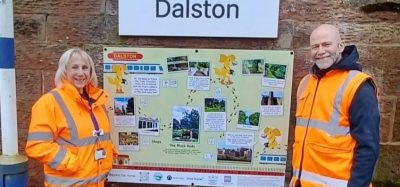Transforming travel
Posted: 3 April 2007 | | No comments yet
A partnership between FirstGroup plc and Keolis was awarded the franchise to provide inter-city and inter-urban passenger rail services to major cities and towns across the north of England, with also the management of 30 stations from 1 February 2004.
A partnership between FirstGroup plc and Keolis was awarded the franchise to provide inter-city and inter-urban passenger rail services to major cities and towns across the north of England, with also the management of 30 stations from 1 February 2004.
A partnership between FirstGroup plc and Keolis was awarded the franchise to provide inter-city and inter-urban passenger rail services to major cities and towns across the north of England, with also the management of 30 stations from 1 February 2004.
As part of its franchise commitment, TransPennine Express (TPE) undertook to deliver:
- Improved passenger information systems to include real-time updates
- Improved CCTV coverage, helping to achieve British Transport Police’s Secure Station and Safer Parking accreditations
Other franchise commitments included a £250m investment to replace the rolling stock, and a £12m station refurbishment programme. The redevelopment of Hull Paragon Railway station into a multi-modal transport interchange was also undertaken in conjunction with Hull City Council.
A few statistics on these stations may help to provide an insight into the scope of the task.
Seven stations are unmanned and 10 stations required local council Listed Building Consent before any alterations could be made. 12 stations had a basic Customer Information System (CIS), none of which afforded any local control. Nine stations were served by automatic train running information i.e. Train Describer (TD) feeds. 26 stations had a manual PA system, with the majority being operated via a Long Line PA (LLPA) agreement from other stations. 13 stations had a very basic CCTV system and there were no Help Points at any stations.
In order to fulfil our commitments, a number of questions needed answers:
- What visual display technology, and in what numbers, should we employ at each of the stations?
- How could we improve real-time reporting of train running information?
- Could we employ self help technology, especially at our unmanned stations?
- How far could we automate the customer information provision along with PA?
- What CCTV coverage was required at each of our stations in order to achieve Secure Station and Safer Parking accreditation?
We enlisted the assistance of consultants, ‘expert’ suppliers, British Transport Police and our own staff, as well as advice from local rail user groups.
Core CIS requirements included:
- Best-in-Class for functionality and reliability
- In addition to TRUST and TD feeds, the system should use additional real-time train running data from other sources such as GPS or Train Mass Detectors (TMD)
- Next Train Indicator (NTI) LED displays on every platform
- 32” Flat screen monitors for indoor locations providing real-time summary information
- Meet DDA requirements for the visually impaired
Core PA requirements included:
- Automatic linking of the announcement to message displayed on CIS
- Announcement can be heard throughout the station
- Zoning so that announcements can be restricted to parts of the station such as individual platforms, concourse etc
- Ability to make manual announcements locally and from remote locations
- Limited noise pollution for our neighbours, business and residential
Core CCTV requirements included:
- Help towards achieving BTP’s Secure Station and Safer Parking accreditation.
- All images recorded at a minimum of 4 fps, and retained for at least 31 days.
- General coverage of the station and car park.
- Enhanced coverage of entry, exit and pinch points within the station and car park.
- Particular coverage of Help Points, bicycle storage and waste containers.
- Each camera location covered in the field-of-view of another camera.
- Ability to view images both locally and remotely.
- The ability to support, at a later date, software for Intelligent Analysis such as suspicious behaviour and potential suicides and Automatic Number Plate Recognition (ANPR).
Core ‘Help Point’ requirements included:
- Being linked to a CCTV system so that the voice link is accompanied by a CCTV image in the Control Room
- Location of the Help Points determined by factors such as manned/unmanned, accessibility to staffed areas, and general information requirements
The ‘Help Point’ requirements must be taken into account for the two types of systems offered, which include:
- The ‘Basic’ system with two buttons; ‘Emergency’ and ‘Information’ that will establish a voice connection with our Operations Control Room in Manchester
- The ‘Interactive’ system with the features of the ‘Basic type’, and additionally a touch sensitive screen to allow self help to information on local area, train running and planning
Choosing the supplier and setting up the project
Due to the unavailability of suitable drawings of the station and car park it was necessary to undertake an extensive survey at every station so that the location of individual items of the system could be planned. These surveys were non-intrusive so would not accurately reflect any buried containment or services.
These survey drawings were developed into 2D CAD models for each station and appropriately structured observing the UK Construction Industry’s recommendations for Best Practice for CAD Data and Information exchange. This approach is consistent with TPE’s committment of Continual Improvement and became the focal point for all our planning and communication of implementation ideas to external agencies as well as our own staff.
The station 2D CAD models are consistent with BS 1192 part 5 which enabled defined workflow for each station to control individual CAD layers indicating the location of CIS screens, PA zones, Cones-of-View for CCTV, and positions for Help Points overlaid on the station plan derived from the site surveys. These were key documents within the Invitation To Tender (ITT) enabling the prospective suppliers to evaluate risks accurately and offer their best value proposition as a consequence. The requirement for ongoing maintenance and support to a specified Service Level Agreement (SLA) to the end of the franchise, 31 January 2012 was added to the ITT
The station 2D CAD models were subsequently used as the basis of the various consent applications including Station Change, Landlord’s Approval and Heritage Consents significantly reducing costs and reducing lead times in the subsequent Project Initiation stage.
The scope of the ITT was further extended to provide a WiFi network capability at each of the stations to provide similar information to the interactive Help Points for our customers, as well as a mobile facility for our staff.
A positive decision was made to combine, in a single activity, the implementation of CIS, PA, CCTV, Help Points and WiFi, thus reducing disruption to our customers at the stations.
The ITT was issued in August 2005 under Official Journal of the European Union (OJEC) guidelines.
Proposals were received from six potential suppliers. A preferred supplier was selected in December 2005. Following due diligence, a contract for supply, implementation, and maintenance until the end of the TPE franchise in January 2012, was signed with Transmitton – a Siemens company, in March 2006. This contract stipulated an extremely ambitious nine month implementation, to complete before year end.
In addition to the Transmitton aspects of the project, further items needed to be undertaken, which included:
- Creating a new desk within the Operations Control Room for the control of CIS and help Point management
- Reorganising the station management structure to reflect seven ‘Hub’ stations for local CIS and CCTV control
- The upgrade to (or the provision of new) 2Mb/sec data communications links to all 30 stations. In some cases, such as the Control Room, the links were upgraded to 8Mb/sec
- To prepare and manage the Network Rail requirement for Station Change
- To prepare and manage Landlord’s Approval from Network Rail
- To prepare and manage Listed Building Consent from local councils
- The supply of Network Rail train running data from TRUST and TD feeds
- The acceptance of the system by our staff
- Training of our staff from stations and Control Room
- The recording of all the voice segments necessary for all the automatic announcements, using the ‘Voice of TPE’ (Selected via an internal competition for an employee voice to be used for automatic announcements on stations and trains)
- The integration and cooperation with the station refurbishment programme
- The design and implementation of the interactive interface and associated data for the Help Point.
With the re-development of Hull Paragon Railway Station into a multi-modal Interchange incorporating both rail and bus, it was agreed to extend the CIS, PA CCTV and Help Point system to be deployed in the railway station to cover the Bus Station. Bus departure information would be displayed on both summary screens, as well as Next Bus departure screens at each of the 42 bus bays.
Project Initiation
A joint project was set up comprising of TransPennine Express (the customer and its consultants), Transmitton Ltd (contract holder and CIS supplier) and Siemens (main contractor to supply and install). Detailed survey and design by Siemens/Transmitton was drawn up to produce input into:
- Station Change
- Landlord’s Approval
- Listed Building Consent
The survey revealed electrical power capacity problems in a number of stations.
The use of Network Rail infrastructure during the implementation phase was avoided as much as possible, with only two stations requiring the use of an Under Track Crossing (UTX).
We needed to deal with two different regions of Network Rail; London North West (LNW) and London North East (LNE), who use different processes to validate the detailed design which is part of Landlord’s Approval.
Waterman Sustainable Energy Ltd, a Network Rail approved structural engineer, was appointed to validate Transmitton’s detailed design before submission to Network Rail for Landlord’s Approval.
On-station meetings were held with local Conservation Officers to obtain mutual understanding of heritage requirements before formal submission of an application for Listed Building Consent was made via Network Rail to the local council. Most Conservation Officers require that any additional equipment should be made as unobtrusive as possible; whereas we had a security and well-being requirement, as well as the deterrent factor, for CCTV cameras and Help Points to be visible. These on station meetings proved invaluable in obtaining compromise and understanding.
The level of detail on submitted documentation required for the approvals and consents was underestimated, and caused delay to the schedule of work, particularly in obtaining site access permissions. The positive side of that however is that once that access was gained, the site works benefited from the detail exercised with swifter works and few installation snags.
The project was registered with the Health and Safety Executive (HSE), as per CDM Regulations, and a Planning Supervisor was appointed.
The first stations selected for implementation were identified as Kendal, Northallerton and Scunthorpe, as they were representative of all the TPE managed stations.
The planned implementation sequence placed those stations requiring Listed Building Consent (Ulverston, Grange-over-Sands, Huddersfield, Dewsbury, Middlesbrough, Malton, Scarborough, Selby, Hull, Cleethorpes) at the end due to the extended time required to obtain such consent. A further station which required a sensitive approach, with local authorities, was Carnforth. Carnforth is a tourist attraction and was the location for the filming of ‘Brief Encounter’ in 1945.
Project implementation and benefits
All equipment has been installed in 23 stations; the remaining stations are awaiting Listed Building Consent from local councils and will be completed when these permissions are granted.
CIS and PA
We envisage have enhanced train running information, even at those stations previously having a basic CIS. Our aim is to feature robust and accurate real-time information on train travel available to all our customers and staff at all our stations, especially when the station is unmanned. Multiple sources for CIS data, especially our TMD implementation has enhanced the accuracy of customer information in areas where previously its accuracy was dubious. Reasons for delay are consistent, and follow the Network Rail definition model. Supplementary information on safety, disruption, replacement services etc can be displayed and announced; this includes automatic safety and security messages. The PA system is set up so that individual platforms, concourse and Booking Hall may be addressed collectively or individually. Automatic PA announcements have enhanced the delivery of visual CIS information. Manual announcements can be made locally, from Hubs and Control Room as necessary for any situation. The use of ambient noise sensors attached to the PA system and automatic brightness sensors connected to the displays has allowed the overall noise and light pollution to be kept to a minimum, which is especially important where we have business and residential neighbours.
Help Points
We have not yet activated the interactive facility on our Help Points. We have investigated the use of Help Points in use within other Train Operating Companies. The activation of a Help Point button presents a real-time CCTV image of the customer on a screen at the Control Room. Our current, voice only, operation of the Help Point is instrumental in our deciding what information to make available via the interactive features that best serves our customers. In the near future, our interactive Help Point facility will at least provide detailed real-time train journey planning, station facilities, local bus and taxi information, as well as details of local attractions, and possibly customer feedback features.
WiFi
A Wireless (WiFi) network has been installed in each of our stations as an extension to the stations Local Area Network (LAN). This WiFi can be used by TPE staff for general Information System (IS) requirements, as well as for the use of operational mobile devices deployed for platform staff. Previously, communication was via the use of GPRS/3G. In the future, we intend to offer our customers access via their mobile devices to the information available on the Help Point. With a possible extension later to a general WEB browsing facility.
CCTV
The implementation of CCTV at our stations has made a major contribution to TPE obtaining BTP Secure Station Accreditation at 23 of our stations, and Safer Parking Accreditation at 16 of our 26 station car parks. Images from the cameras at a rate of 12? frames per second are stored for a minimum of 35 days. Our use of CCTV is registered under the Data Protection Act 1998 for the safety and security of staff and customers, as well as for the monitoring of customer service. The stored images can be transferred to DVD for use as evidence of any on station incident. The real time images from the cameras have been offered to local council city/town CCTV monitoring facilities to aid the tracking of incidents from/to station to/from city/town centre. Use of CCTV and stored images is managed and controlled by TPE for monitoring/review of safety and other operational incidents, as well as for the monitoring of the operational day-to-day running of our stations. We fully expect that the deterrent value of CCTV cameras, as well our close liaison with BTP with any incident will have an overall reduction in crime and security incidents within our stations.
Control Room
Significant changes have been made to the operation within our Manchester Control Room. This was basically an internal function but has now been extended to a direct interface with our customers. This interface affected by messages to CIS displays, manual PA announcements, and the answering of queries and emergencies from the Help Points.
Hubs and Satellite Stations
Organisational change in the management of the stations, with the concept of Hub and satellite stations, has provided a greater interaction and thus enhanced information flow for local staff. With local control of CIS in Hub stations, and Manchester Control Room, we get a consistent view of train operations across TPE. With Hub stations already having a local relationship with Network Rail signal box operatives, data input to the CIS is more accurate and robust.
General Benefits
High quality 2D CAD models for each station including a dedicated ‘As-Installed’ layer which will be used as the starting point for future investment at stations, modification and maintenance of the CIS & CCTV scheme and thereby contributing to overall life-cycle costs – a key aim of the project. Power capacity at all the TPE stations has been reviewed, and upgraded where necessary. A preventative maintenance regime is in place, for the full term of TPE’s franchise, which ensures equipment does not fail to provide the level of functionality defined within ITT. A corrective maintenance provision with a Help Desk is also in place for the full term of TPE’s franchise.
Overall, the implementation of CIS, PA, Help Points, WiFi and CCTV, along with other franchise commitments is seeking to make travelling on TPE safer, more reliable, with accurate and up to date information. As First Group would simply say; “Transforming Travel”.
About the author
Ian Benger started with TransPennine Express some six months before the start of the franchise, in order to set up the IT/IS infrastructure. His role as a project manager was extended to managing the delivery of particular franchise commitments. He has had previous senior roles at Compaq, DHL, Securicor and ICL
Issue
Related topics
Passenger Information Systems (PIS), Security & Crime Management, Station Developments







